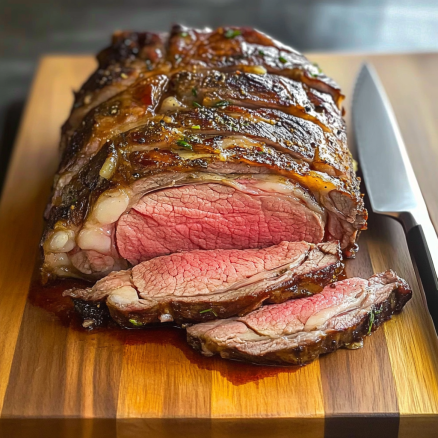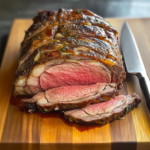A gourmet centerpiece for any special occasion, this Garlic Herb Prime Rib Roast features a succulent, tender interior enveloped by a flavorful herb-crusted exterior. Juicy, impressive, and surprisingly easy to prepare, it elevates any gathering.
Why You’ll Love This Recipe
- Elegant simplicity: With just garlic, herbs, salt, and pepper, this roast delivers rich, sophisticated flavor.
- Incredibly tender: Slow roasting with a reverse-sear method creates a perfect pink center with a crisp, caramelized crust.
- Show-stopping presentation: A whole rib roast instantly adds elegance to your table and impresses guests.
- Make-ahead option: Rub the meat the day before to deepen flavor and ease day-of prep.
Ingredients
(Tip: You can find the complete list of ingredients and their measurements in the recipe card below.)
- 1 prime rib roast (ribeye roast) with 3–4 ribs, bone-in or boneless
- Garlic cloves, minced
- Fresh rosemary, chopped
- Fresh thyme, chopped
- Olive oil or softened butter
- Salt & freshly ground black pepper
Directions
- Season 24 hours ahead (optional but recommended)
Combine minced garlic, herbs, olive oil (or butter), and generous salt and pepper. Rub all over the roast, then wrap and refrigerate uncovered for 24 hours to allow flavors to penetrate and meat to dry for crispier crust. - Bring roast up to room temperature
Remove roast from fridge 2 hours before cooking to ensure even roasting. - Slow-roast for tenderness
Preheat oven to 135 °C (275 °F). Place roast bone-side down (or fat-side up) on a rack in a roasting pan. Insert an oven-safe meat thermometer if available. Cook until internal temperature reaches 48 °C (118 °F) for medium-rare, about 2–2½ hours. - Rest before searing
Remove roast and tent loosely with foil; rest for 30 minutes. Meanwhile, increase oven temperature to 260 °C (500 °F). - Reverse-sear for crust
Return roast to oven for 10–12 minutes, or until a deep golden-brown crust forms and internal temperature reads 52–55 °C (125–130 °F) for medium-rare. Remove and let rest 20 minutes; carryover heat will raise to 57–60 °C (135–140 °F). - Slice and serve
Transfer roast to a cutting board. Slice between ribs or across roast into thick slices. Serve with au jus, horseradish, or creamy horseradish sauce on the side.
Servings and timing
- Servings: Serves 6–8 (approx. 3–4 ribs depending on side dishes)
- Prep time: 10 minutes (plus optional overnight seasoning)
- Cook time: 2½–3 hours
- Rest time: 50–60 minutes
- Total time: ~3–4 hours
Variations
- Different herb profiles: Swap rosemary and thyme for sage, tarragon, or parsley to change the flavor tone.
- Flavored crust addition: Add Dijon mustard under the garlic-herb rub for tangy depth.
- Seasoned butter compound: Blend butter with anchovy paste or grated Parmesan then spread over roast prior to cooking.
- Spice-rub option: Mix kosher salt, black pepper, garlic powder, and paprika for a peppery alternative.
Storage / Reheating
- Storage: Refrigerate sliced or whole roast in an airtight container for up to 3 days. Keep au jus or cooking juices separately.
- Freezing: Freeze slices wrapped tightly in foil or plastic wrap for up to 2 months.
- Reheating:
- Oven method: Wrap roast in foil with a splash of beef broth, reheat at 150 °C (300 °F) for 15–20 minutes.
- Stovetop method: Slice roast thinly and warm in skillet with a bit of butter or broth over low heat until just heated through.
Tips for the best results
- Dry aging effect: Refrigerating uncovered enhances crust development and intensifies flavor.
- Use a meat thermometer: For precision cooking and avoiding over- or under-done meat.
- Low-and-slow method: Slow roasting ensures even doneness from edge to center.
- Resting is essential: Allows juices to redistribute for a moister roast.
- High-heat finish: Reverse-searing locks in juices and creates an exceptional crust.
FAQs
1. What’s the difference between prime rib and ribeye roast?
They are the same cut—“prime rib” often refers to the prime-graded version; ribeye is the boneless version or after bone removal.
2. Can I skip the overnight seasoning?
Yes—the roast will still be delicious, but advanced seasoning deepens flavor and improves crust.
3. How do I adjust for medium doneness?
Aim for a final internal temperature of 60–62 °C (140–145 °F); adjust resting and searing times accordingly.
4. Should I use bone-in or boneless?
Bone-in adds flavor and makes carving simpler, but boneless is easier to slice and serves similarly.
5. Can I cook this entirely at high temperature?
You could, but slow-roasting then high-heat finishing yields more uniform cooking and better texture.
6. How do I store leftover au jus?
Pour juices into a sealed container; refrigerate for up to 3 days or freeze for future use.
7. What side dishes pair best?
Classic pairings include mashed potatoes, roasted root vegetables, Yorkshire pudding, green beans, or a fresh green salad.
8. Can I reheat without drying out?
Yes—use a low oven with broth and foil, or pan-sear gently; avoid high heat or fast reheating.
9. Will crust get soggy if I store leftovers cooked?
Occasionally—but you can re-crisp briefly under a broiler before serving.
10. Is premium-grade beef necessary?
No—but well-marbled roasts (choice or prime) perform best, especially using the reverse-sear method.
Conclusion
The Garlic Herb Prime Rib Roast is a timeless dish that brings elegance to any celebration. With a tender center, flavorful crust, and stunning presentation, it’s a recipe worth mastering for both special occasions and indulgent dinners.
Pro tip: Try resting the roast overnight after cooking before carving—it improves juice retention and flavor!
Ready to amaze your guests? Order your roast, plan your sides, and create a memorable feast tonight. Share your chosen side dishes or carving technique—I’d love to hear how your prime rib turns out!
PrintGarlic Herb Prime Rib Roast
A gourmet centerpiece for special occasions, this Garlic Herb Prime Rib Roast delivers a tender, juicy interior and a beautifully crisp, herb-crusted exterior—elegant yet surprisingly easy.
- Prep Time: 10 minutes (plus optional overnight seasoning)
- Cook Time: 2½–3 hours
- Total Time: ~3–4 hours
- Yield: Serves 6–8 (3–4 ribs) 1x
- Category: Main Dish
- Method: Roasting (Reverse‑Sear)
- Cuisine: American/Western
Ingredients
1 prime rib roast (ribeye roast), 3-4 ribs, bone‑in or boneless,4-6 garlic cloves, minced,2 tbsp fresh rosemary, chopped,2 tbsp fresh thyme, chopped,2-3 tbsp olive oil or softened butter,Kosher salt & freshly ground black pepper
Instructions
Season ahead (optional but recommended): Combine garlic, herbs, olive oil (or butter), salt, and pepper. Rub evenly over roast, wrap, and refrigerate uncovered for 24 hours to enhance flavor and crust.,Bring roast to room temperature: Remove from fridge about 2 hours before cooking.,Slow‑roast: Preheat oven to 135 °C (275 °F). Place roast bone‑side down (or fat‑side up) on a rack in a roasting pan. Insert a meat thermometer. Roast until internal temperature reaches 48 °C (118 °F) for medium‑rare, about 2–2½ hours.,Rest before searing: Tent roast loosely with foil; rest 30 minutes. Increase oven temp to 260 °C (500 °F).,Reverse‑sear: Return roast to oven for 10–12 minutes until the crust turns deep golden and internal temp reads 52–55 °C (125–130 °F). Remove and let rest 20 minutes (will climb to 57–60 °C/135–140 °F).,Slice and serve: Carve between ribs or into thick slices. Serve with au jus, horseradish sauce, or creamy horseradish on the side.
Notes
Seasoning overnight enhances flavor and crust formation.,Resting twice helps seal in juices and improves tenderness.,Use a meat thermometer for accurate doneness—aim for internal temps noted above.,For added flavor, spread Dijon mustard under the herb rub or use a compound herb butter.,For variation, mix in other herbs like sage, tarragon, or parsley.
Nutrition
- Serving Size: 150 g
- Calories: 400 kcal
- Sugar: 0 g
- Sodium: 320 mg
- Fat: 32 g
- Saturated Fat: 13 g
- Unsaturated Fat: undefined
- Trans Fat: undefined
- Carbohydrates: 0 g
- Fiber: 0 g
- Protein: 28 g
- Cholesterol: 110 mg


